|

by Irene Klotz
April 18, 2013
from
Reuters Website
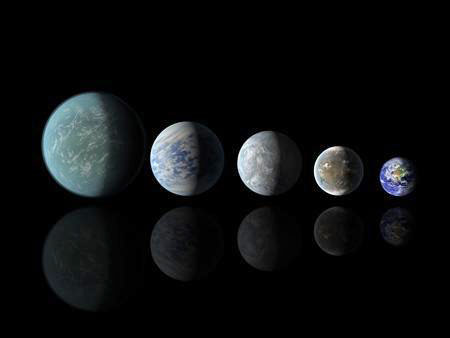
Relative sizes of
Kepler habitable zone planets discovered
as of April 18, 2013
in this artist's rendition provided by NASA.
Credit: Reuters/NASA Amers/JPL-Caltech/Handout
CAPE CANAVERAL, Florida
Scientists using NASA's
Kepler space telescope have found
the best candidates yet for habitable worlds beyond the solar
system, including a pair of potentially life-friendly planets
orbiting the same star, officials said on Thursday.
The planets join a list of about 700 confirmed extra-solar planets
discovered since 1995.
The new additions include a pair of planets orbiting a
star called Kepler-62, located
about 1,200 light years away in the
constellation Lyra (see also
'The Prism of Lyra').
Kepler-62's two outermost planets, both about 1.5 times the size of
Earth, are located the right distance from their parent star for
water -
if 'any' exists - to be liquid on
the surface.
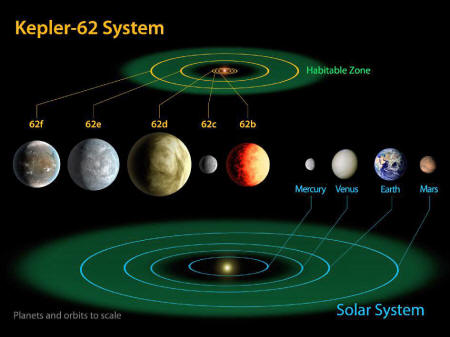
Water is believed to be necessary for
life.
"These two planets are our best
candidates for planets that might be habitable, not just in the
habitable zone," Kepler lead scientist William Borucki, with
NASA's Ames Research Center in Moffett Field, California, told
reporters on a conference call.
Computer models indicate the two
planets, designated Kepler-62e and 62f, likely are solid bodies
comprised of rock, ice or a mix of rock and ice.
The pair have three sister planets that also circle Kepler-62, but
those are too close their parent star and likely too hot for surface
water.
The Kepler telescope measures slight dips in the amount of light
coming from target stars that may be caused by planets passing by,
or transiting, relative to the telescope's line of sight.
So far, the Kepler science team has more than 2,700
candidate planets.
Scientists also found two planets circling another Kepler target
star,
Kepler-69, located about 2,700
light years from Earth in the
constellation Cygnus (se also 'The
Cygnus Mystery').
Light travels at about 186,000 miles per second, or about 6 trillion
miles (10 trillion km) in a year.
The innermost planet is about twice the size of Earth and orbits its
parent star in just 13 days, too close for liquid surface water. The
second planet, however, which is about 70 percent bigger than Earth,
orbits about where Venus is located in the solar system, putting it
on the edge of the star's so-called "habitable zone."
More powerful telescopes than Kepler will be needed to fish out more
detail about whether the extrasolar planets do indeed 'have water.'
"We're still progressing to find the
first truly Earth-like worlds," said astronomer Thomas Barclay,
with the Bay Area Environmental Research Institute in Sonoma,
California.
The research (Kepler-62
- A Five-Planet System with Planets of 1.4 and 1.6 Earth Radii in
the Habitable Zone) is being published in Science and the
Astrophysical Journal this week.
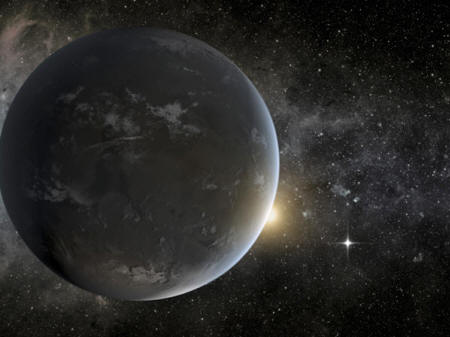
This artist's concept
provided depicts
NASA's Kepler
mission's smallest habitable zone planet.
Photo: AP
Kepler Spies Water Worlds
-
Pair of Exoplanets Sit in Habitable Zone of
Star Far Beyond The Solar System -
by Ron Cowen
18 April 2013
from
Nature Website
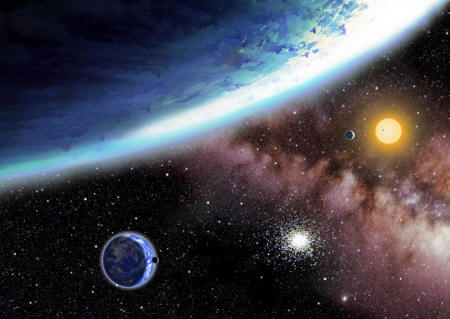
This illustration shows Kepler-62f,
a newly discovered
extrasolar planet (top)
and a similar body,
Kepler-62e (bottom left).
David A. Aguilar/CFA
NASA's Kepler spacecraft has discovered two planets that are the
most similar in size to Earth ever found in a star's habitable zone
- the temperate region where water could exist as a liquid.
The finding, reported online today in Science1, demonstrates that
Kepler is closing in on its goal of finding a true twin of Earth
beyond the Solar System, says theorist Dimitar Sasselov of
the Harvard-Smithsonian Center for Astrophysics in Cambridge,
Massachusetts, who is a member of the Kepler discovery team.
Both planets orbit the star Kepler-62, which is about two-thirds the
size of the Sun and lies about 1,200 light years (368 parsecs) from
the Solar System. The outermost planet from the star, Kepler-62f,
has a diameter that is 41% larger than Earth's and takes 267 days to
circle its star.
The inner planet, Kepler-62e, has a
diameter 61% larger than Earth's and a shorter orbit of 122 days.
Kepler detected the planets by recording
the tiny decrease in starlight that occurs when either of them
passes in front of their parent star. Astronomers used those
measurements to calculate the planets' relative size compared to
that star.
Worlds apart
In the Science paper (Kepler-62
- A Five-Planet System with Planets of 1.4 and 1.6 Earth Radii in
the Habitable Zone), the Kepler team - led by principal
investigator William Borucki of NASA - suggests that the
planets are solid, but may be rocky or icy.
But Sasselov believes that the two orbs
are likely to be covered entirely by oceans, based on his own
unpublished analysis co-authored with colleagues at
Harvard-Smithsonian and the Max Planck Institute for Astronomy in
Heidelberg, Germany. They theorize that the two water worlds are
either liquid all the way down to their core or have a solid surface
just beneath a shallower ocean.
The latter model would be more conducive
to life as we know it on Earth, where a recycling of material and
energy from hydrothermal vents can sustain organisms, Sasselov says.
But some recycling could also occur in a much deeper ocean, owing to
deposits of methane and other volatiles trapped in a layer of
high-pressure, underground ice that could later be released by
convection into the liquid, he notes. Sasselov and two other
collaborators describe that model in a preprint on the arXiv
server2, which is due to be published in the Astrophysical Journal.
The planets' properties "are all consistent with being habitable",
says Lindy Elkins-Tanton, who directs the department of
terrestrial magnetism at the Carnegie Institution for Science in
Washington DC.
However, it is not guaranteed that the
two planets have enough carbon dioxide, a greenhouse gas, to keep
the planet warm enough so surface water can exist as a liquid as the
researchers have assumed, she cautions.
Jonathan Lunine, a planetary scientist at Cornell University
in Ithaca, New York, says that it is impossible to know the
composition of the two exoplanets because scientists have not been
able to calculate their masses.
That is because
Kepler-62e and Kepler-62f exert too
feeble a gravitational tug on their parent star to be detected by
any existing telescope.
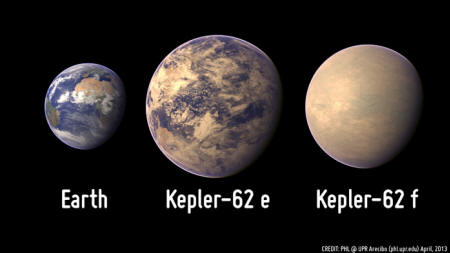
The planets also lie too far away from
Kepler-62 for astronomers to use its light to hunt for chemical
elements in the planets' atmospheres.
Nonetheless,
"these are the closest yet to the
Earth twin everyone wants to see," Lunine says.
References
|





